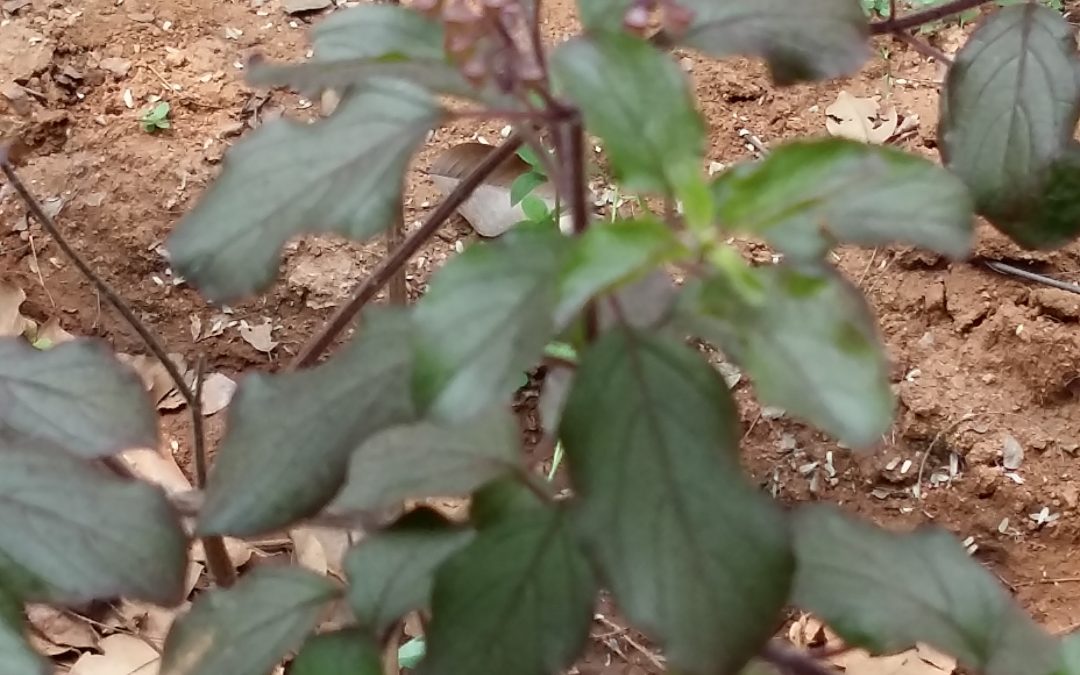Let me present some verified facts on the medicinal properties of Holy basil, botanical name Ocimum tenuiflorum. Holy Basil, or tulsi, is an aromatic plant revered by Hindus. The herb occupies a place of pride in most Hindu homes’ center courtyards. It is not uncommon for Hindus to keep a tulsi plant in a pot, even in high-rise apartments these days, indicating the reverence it commands.
Some describe the plant as “The Mother Medicine of Nature,” and it is referred to as such in ancient Hindu literature. Every part of the plant is fragrant—the leaves, seeds, and flowers. When in bloom, the fragrance of the tulsi is keenly felt. The plant seeds profusely. Natural regeneration is profuse.
There are three varieties of plants. Two of these are named after the Hindu gods Krishna and Rama—Krishna Tulsi and Rama Tulsi. The former has purple-tinged leaves, and the latter is mostly green. A third variety—Van Tulsi (“van” in Sanskrit means “forest”)—grows in the wild. All three varieties have similar aromatic and medicinal properties.
The herb is mentioned in Charaka Samhita. There are monographs of O. tenuiflorum published in the Ayurvedic Pharmacopoeia of India (Vol. II, 1999, and Vol. IV, 2004), Unani Pharmacopoeia of India (Vol. V, 2008), Thai Herbal Pharmacopoeia (Vol. I, 1995), Vietnamese Pharmacopoeia (1st ed., 1983), and World Health Organization (WHO) Monographs (Vol. 2, 2002). Most of these medicine systems recommend using the Holy Basil to treat arthritis, respiratory ailments, fever, influenza, stomach ailments, etc. Tulsi is a common ingredient in many Ayurveda and Unani medicines.
In the US, holy basil is permitted in dietary supplements. Its use in cosmetic products is included in the European Commission Health, and Consumer Directorate lists under the “permitted” category. The plant extracts are used in skin-conditioning, emollient, and hair-conditioning products.
Ocimumosides A, B, and ocimarin are three compounds isolated from an extract of leaves of holy basil that were proven to have anti-stress effects. The anti-stress properties of the herb have been validated in multiple studies (Archana et al., 2002; Samson et al., 2006; Samson et al. (2007; Ravindran et al., 2005). Its neuroprotective properties have also been observed in multiple studies (Yanpallewar et al., 2004; Siddique et al., 2007).
The antioxidant properties of tulsi were observed by Subramanian et al., 2013) and), who also observed that it caused a reduction in oxidative stress in the brain. Tulsi was noted to have an amelioration property when the sciatic nerve was cut to induce neuro dysfunction in rats (Muthuraman et al., 2008). This property could have value in finding treatments for the dysfunctions caused by nerve damage.
Tulsi helps normalize hyperglycemia, plasma corticosterone, plasma creatine kinase, and adrenal hypertrophy (Gupta et al., 2007; Sembulingam et al., 2005; Sen et al., 1992; Archana et al., 2000). Experiments on rabbits show that holy basil reduced lipid levels (Geetha et al., 2004). Lipid reduction and antioxidant properties were also observed in another study (Manikandan et al., 2007). The cardioprotective property of the herb was kept, and results were published in another study (Mohanty et al., 2006).
Several studies have examined the role of Ocimum sanctum in treating diabetes (Kapoor, 2008). This study showed that it is effective in preventing insulin resistance. A similar property was observed in experiments on rats (Reddy et al., 2008). The herb leaves partially attenuated glycogen content and modulated carbohydrate metabolism in rats (Vats et al., 2004). Multiple studies also observed anti-diabetic properties (Hannan et al., 2006; Agrawal et al., 1996).
The herb’s action against multiresistant strains of gonorrhea-causing organisms has been studied and validated (Shokeen et al., 2008; Shokeen et al., 2005). The action of holy basil as a chemo-preventive medicine has also been studied and validated (Nayak et al., 2005; Dutta et al., 2007; and Manikandan et al., 2007). The herb also protects against induced skin tumors in experimental mice (Rastogi et al., 2007). The plant was observed to possess radioprotective, anti-carcinogenic, and antioxidant properties (Uma Devi, 2001). The oil from the seed was found to have chemopreventive properties (Prakash et al., 2000).
Anti-ulcer and ulcer-healing properties of the herb were also observed (Dharmani et al., 2004; Goel et al., 2005; Kath et al., 2006; and Singh et al., 1999). Vasudevan et al. (2001) studied its action against enteric pathogens. The plant was found to possess a reversible anti-fertility effect on experiments conducted on rats (Ahmed et al., 2002).
This is just a brief overview of the medicinal properties of this plant. For those who are interested in knowing more, here are some references:
